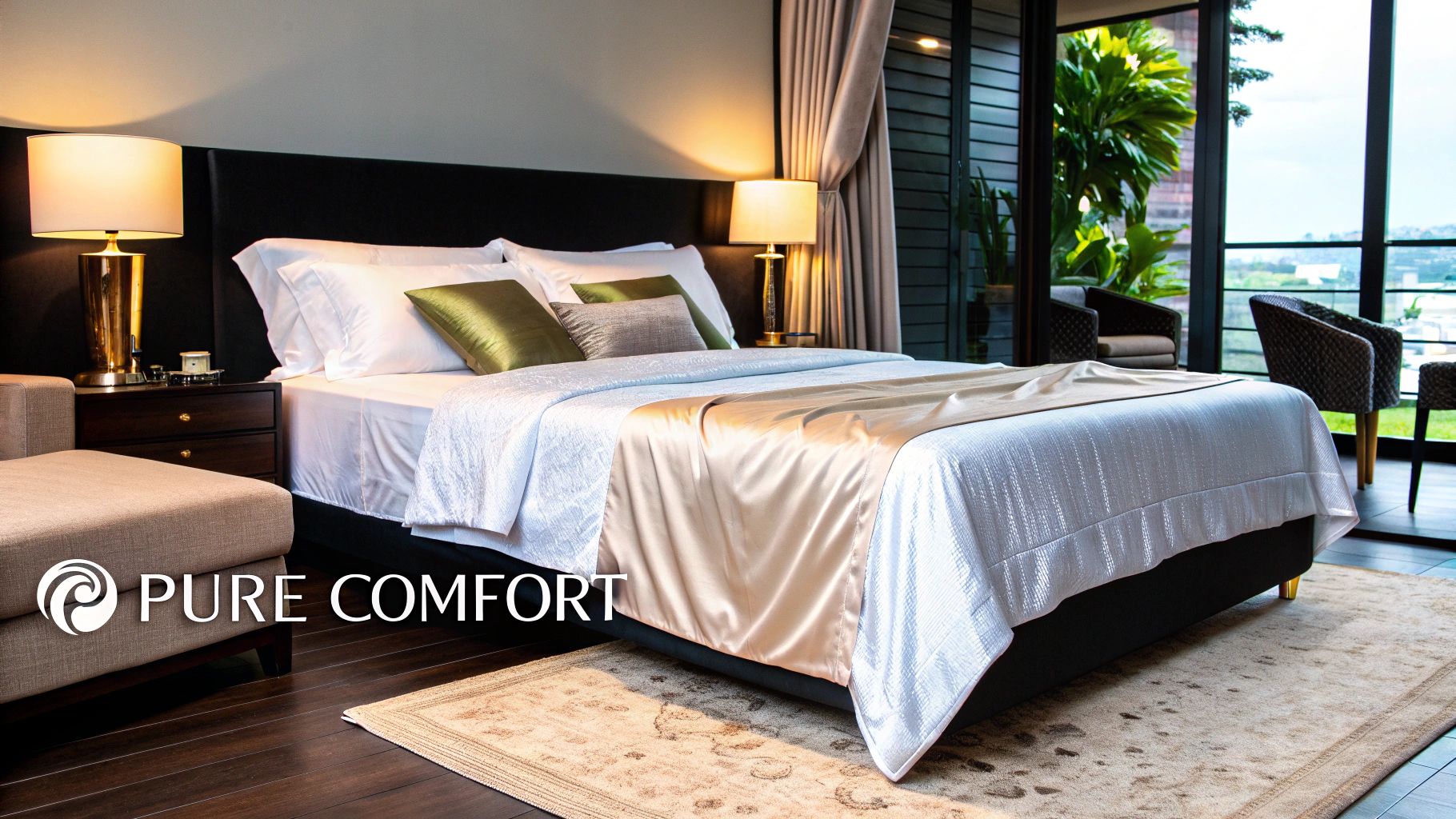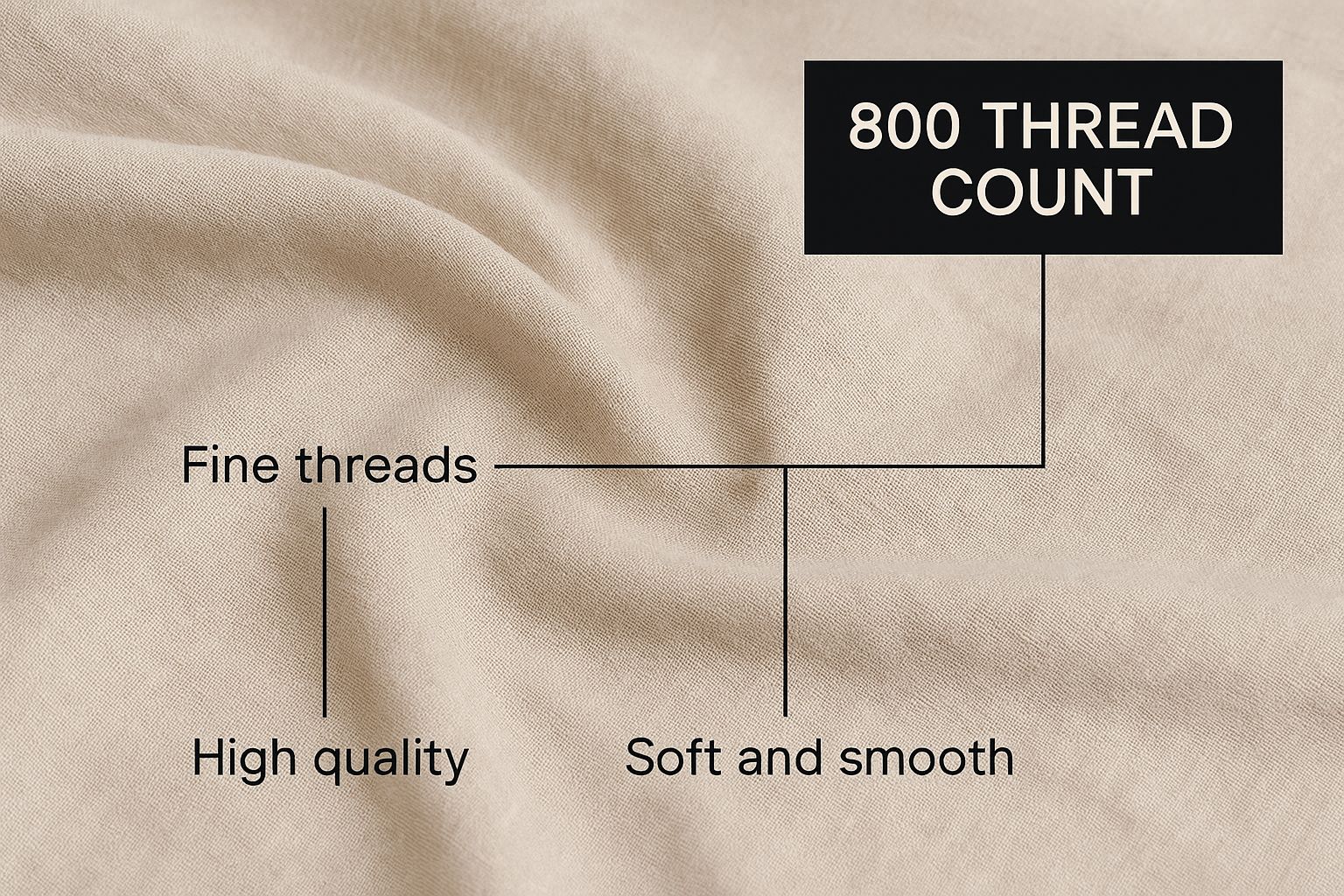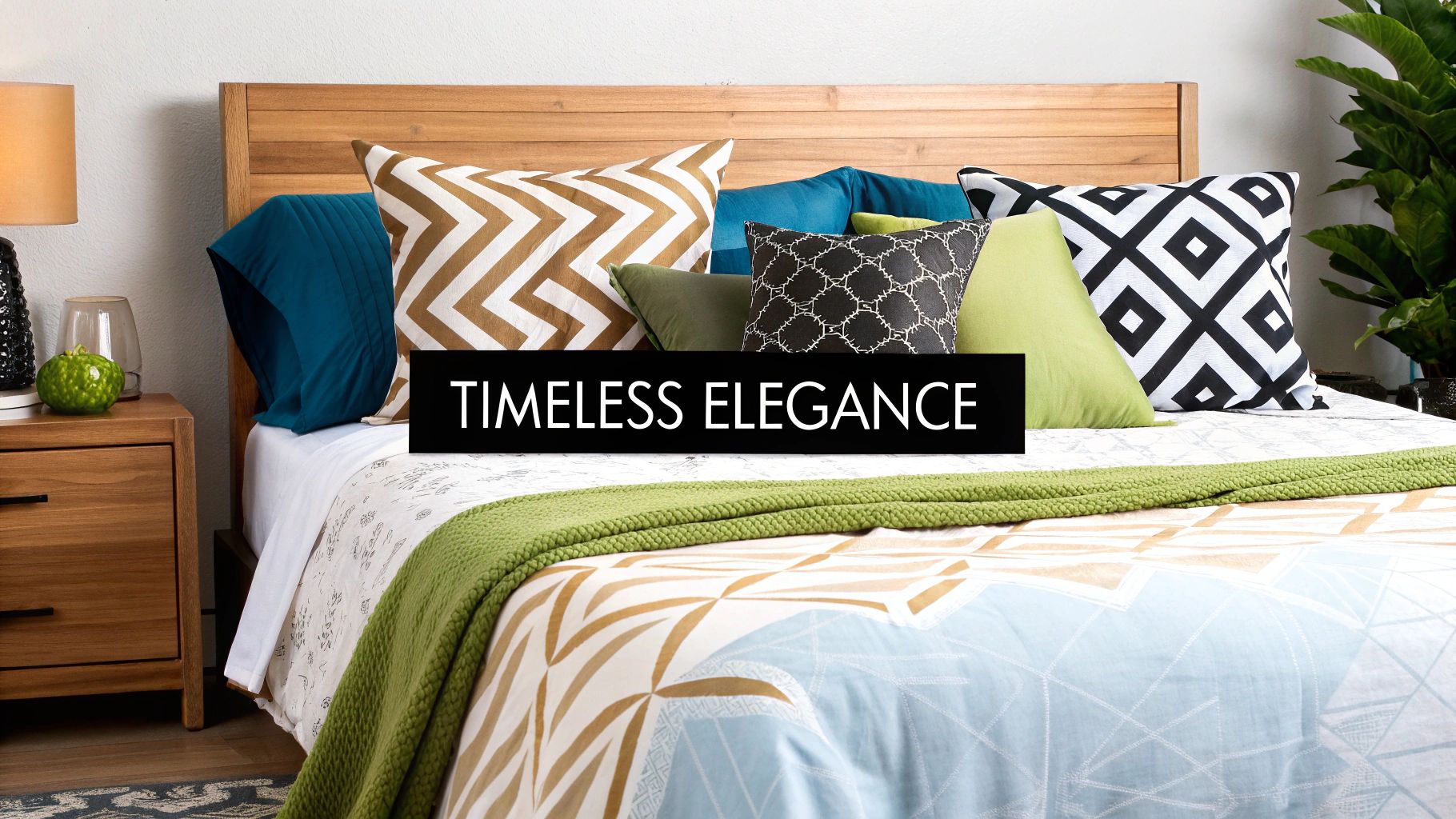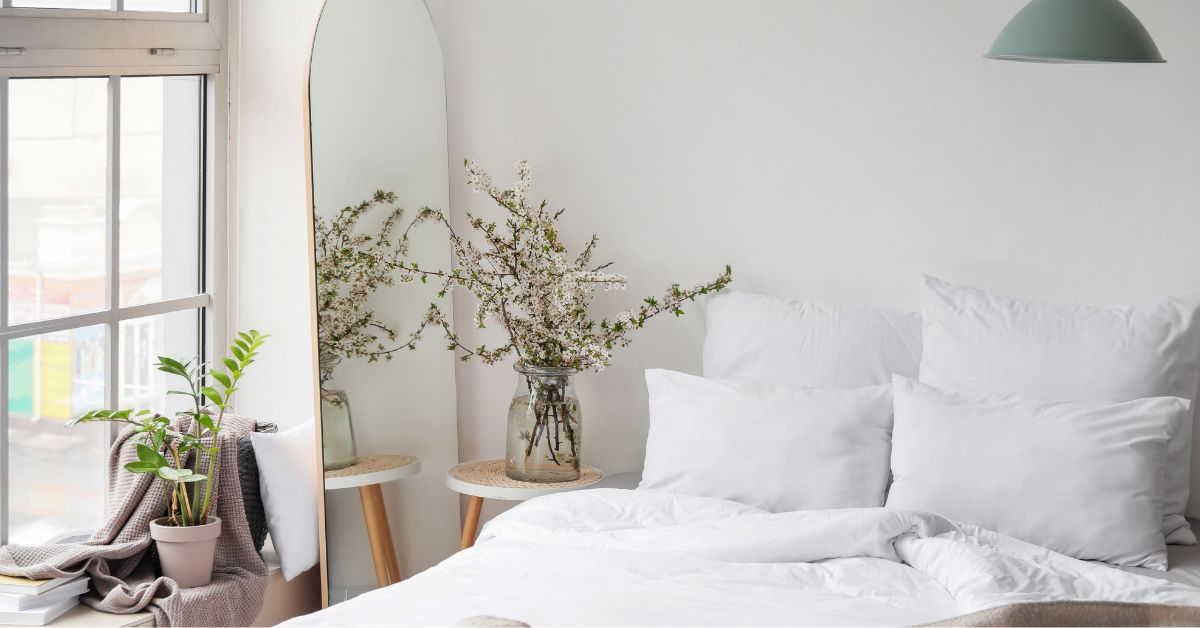When you hear the term “luxurious bed linens,” what comes to mind? It’s easy to think of a high price tag, but true luxury is much more than that. It’s about the feel of exceptional materials, the touch of expert craftsmanship, and the wonderful sensation against your skin. This is an investment in your nightly comfort, turning your bed into a genuine sanctuary for rest.
What Makes Bed Linens Genuinely Luxurious
Real luxury in bedding is an experience. It’s the cool, smooth touch of a premium sheet after a long day or the gentle weight of a beautifully made duvet helping you drift into a deeper, more restorative sleep. When you invest in high quality linens, you're investing in yourself and countless nights of incredible comfort.
So, what really separates everyday sheets from genuinely luxurious ones? It comes down to a few key elements that work together to create that five star hotel feeling right in your own home. Let’s move past the marketing talk and focus on what truly matters for your comfort.
The Foundation of Quality Materials
The journey to luxury always begins with the raw materials. The finest linens are crafted from long staple or extra long staple cotton fibres, like those you find in world renowned Egyptian or Pima cotton.
Think of these long fibres as being like strong, unbroken threads of silk. When they're spun into yarn, they create a fabric that is:
-
Incredibly Soft: With fewer tiny fibre ends poking out, the surface is unbelievably smooth and feels wonderful against your skin.
-
More Durable: Longer fibres are stronger. This means the fabric resists pilling and stands up to wear and tear, making your investment last for years.
-
Highly Breathable: Premium fabrics allow air to circulate more freely, which helps regulate your body temperature for a far more comfortable night's sleep.

Craftsmanship and Attention to Detail
Of course, the material is only half the story. The way the linens are actually made is just as crucial. You can spot expert craftsmanship in the smallest details, from the precision of the stitching to the flawless finish of the fabric. Many heritage brands tailor their sheets with meticulous care, ensuring every seam is perfect and every corner is neatly finished.
This appreciation for quality is a growing trend. The United Kingdom's luxury bedding market was valued at USD 88.4 million and is projected to climb to USD 138.5 million by 2035, fuelled by a greater desire for upscale home comforts. You can find more details about this trend in the UK luxury bedding market report from Spherical Insights.
This shift shows that more of us are realising the profound impact that well made linens can have on our quality of life. My goal is to give you the knowledge to choose linens that don't just look good, but bring you a little bit of joy every single night.
Choosing Your Ideal Bed Linen Material
Picking the right fabric for your bedding is the first step towards discovering what real comfort feels like. It’s a bit like choosing the perfect jumper. Some are light and airy for mild evenings, while others are thick and cosy for the middle of winter. The material of your bed linens works in much the same way, directly shaping the quality of your sleep.
Let’s walk through the most popular luxury materials. I'll break down what makes each one special, focusing on how it feels and performs, so you can find the perfect match for your personal sleep style.
Egyptian Cotton: The Gold Standard of Softness
When you picture those crisp, unbelievably soft hotel sheets, you’re almost certainly thinking of Egyptian cotton. This isn’t just a fancy name, it's a true hallmark of quality. The secret is in its extra long staple fibres, which are significantly longer and finer than those found in regular cotton.
These unique fibres are spun into exceptionally smooth, strong yarn. The result? Sheets that are not only incredibly soft but also remarkably durable and breathable. Best of all, they actually get softer with every wash, making them a brilliant long term investment in your comfort.
Linen: Effortlessly Cool and Relaxed
If you’re someone who tends to sleep warm, linen could be your new best friend. Made from the fibres of the flax plant, it’s one of the most breathable fabrics you can find. It’s a natural temperature regulator, brilliant at keeping you cool in the summer and, surprisingly, warm and cosy in the winter.
Beyond its practical side, linen just has that beautiful, laid back look that brings a touch of understated elegance to a bedroom. It has a distinct, slightly textured feel that softens beautifully over time, creating a welcoming, lived in feel.
"Choosing the right material is less about finding a single 'best' option and more about discovering what feels best for you. Let your personal preference for feel, temperature, and even the look of the fabric guide your decision."
The image below gives you a close up look at the fine texture of a high quality fabric, showing how a dense weave creates that signature luxurious feel.

This close up really showcases the intricate weave of a premium fabric, where a high thread count creates a smoother and more durable surface.
Silk: The Ultimate Indulgence
For pure opulence, nothing quite compares to silk. Famous for its incredibly smooth, gentle touch, sleeping on silk is a truly special experience. It’s also naturally hypoallergenic, which makes it a fantastic choice for anyone with sensitive skin or allergies.
Silk is also well known for its beauty benefits. Its smooth surface means less friction against your skin and hair, which can help prevent sleep creases and tangles. It’s a little touch of daily pampering that helps you wake up feeling refreshed. Of course, getting the size right is also key. You can find out more about the perfect fit in our guide to the king size bedsheet size in cm to ensure a beautiful drape.
Modern, Sustainable Choices
In addition to traditional favorites, some exceptional contemporary materials have emerged, offering both luxury and environmentally friendly attributes. These fabrics are gaining popularity for their silky texture and responsible production processes.
-
Tencel™ Lyocell: Crafted from sustainably sourced wood pulp, Tencel™ offers a beautiful, fluid drape and a cool, silk-like touch. It effectively wicks away moisture, making it an ideal choice for those who tend to sleep warmly.
-
Bamboo: Bamboo fabric is appreciated for its soft texture and natural antibacterial properties. It is highly breathable and gentle on the skin, providing a comfortable and hygienic sleep environment that is also eco-friendly.
-
Egyptian Cotton: Known for its all-around luxury and durability, Egyptian cotton is crisp, smooth, and incredibly soft, becoming softer with every wash.
-
Cooling Fabric: Our Morgan and Reid sheets, which feature a cooling fabric with a q-max of 0.45, offer an excellent alternative. These performance fabrics do not rely on thread count, instead providing a unique cooling experience.
To assist you in making a choice, here is a concise comparison of the materials discussed.
Comparing Luxurious Bed Linen Materials
This comparison can aid in selecting the best fabric for your personal comfort and style preferences.
Material |
Best For |
Feel |
Key Benefit |
|---|---|---|---|
Egyptian Cotton |
All-around luxury and durability |
Crisp, smooth, and incredibly soft |
Becomes softer with every wash |
Linen |
Warm sleepers and a relaxed aesthetic |
Lightly textured, airy, and breathable |
Provides excellent temperature regulation |
Silk |
The ultimate indulgent experience |
Incredibly smooth, cool, and gentle |
Hypoallergenic, kind to skin and hair |
Tencel™/Bamboo |
Eco-conscious and warm sleepers |
Silky, smooth, and cool to the touch |
Sustainable with excellent moisture wicking |
Cooling Fabric |
Those seeking a cooling experience |
Refreshingly cool and smooth |
Features a q-max of 0.45 for outstanding cooling |
Ultimately, the ideal fabric is the one that makes you look forward to bedtime each night. Whether you desire the crispness of cotton, the cool touch of linen, or the innovative cooling properties of performance fabrics, selecting a material you love is key to a truly luxurious sleep.
Understanding Weave and Thread Count

When you're searching for beautiful bed linens, the term "thread count" seems to pop up everywhere. For years, we've been told that a higher number means better sheets, but that’s only a small part of a much bigger story.
So, what is it? Thread count is simply the total number of threads woven into one square inch of fabric. While a high count can certainly create a denser, smoother material, it’s not the magic number for luxury. The real secret lies in the quality of the yarn itself, the individual threads.
Think of it like cooking. You could use a thousand average quality ingredients, but the result will never taste as good as a dish made with a handful of the very best. It’s the same with sheets. This is why many of the world's most coveted linens have a thread count between 400 and 800. The focus isn't on cramming in more threads. It's on using superior quality cotton and a masterful weave.
The weave is how those threads are interlaced, and it’s what truly defines how the fabric feels against your skin.
The Great Debate: Percale vs Sateen
In the world of luxury bedding, two weaves consistently take the spotlight, percale and sateen. Each offers a completely different experience, and knowing the difference is the key to finding a texture you’ll adore. This matters far more than any number on the packaging.
Percale is your crisp, cool classic. It’s crafted with a simple ‘one thread over, one thread under’ pattern, a bit like a high quality dress shirt. This straightforward weave creates a light, breathable fabric with a lovely matte finish that feels wonderfully refreshing.
Sateen, on the other hand, is woven with a more complex ‘one thread under, three or four threads over’ structure. This method exposes more of the thread’s surface, giving the fabric its signature silky smooth feel and a subtle, elegant lustre. It drapes beautifully and has an incredibly buttery touch.
"Your choice between percale and sateen is purely personal. It's about deciding whether you prefer the cool crispness of a classic hotel sheet or the silky, cosy drape of something more indulgent. Neither is better, they simply offer different paths to comfort."
Selecting the Appropriate Weave
How do you make your choice? It essentially depends on your personal preferences and sleep style. Here's a breakdown of the benefits to assist you in identifying the most suitable option.
Percale might be ideal for you if you:
-
Sleep warm: Its airy and breathable characteristics allow heat to dissipate, ensuring a cool and comfortable night's rest.
-
Appreciate a crisp, fresh feel: If you enjoy the sensation of a freshly laundered shirt, you'll appreciate the clean, crisp texture of percale.
-
Reside in a warmer climate: For those living in areas like Australia or southern Europe, percale is often the preferred choice for consistent comfort throughout the year.
Sateen may be your best choice if you:
-
Favor a softer, silkier touch: The smooth surface of sateen offers a comforting and luxurious feel.
-
Feel chilly at night: With its tighter weave, sateen provides a slightly warmer and cozier experience compared to percale.
-
Desire a more elegant, lustrous appearance: The subtle sheen of sateen imparts a touch of sophistication and drapes elegantly on the bed.
Cooling fabrics might be worth considering if you:
- Seek temperature regulation: Designed to enhance breathability and moisture-wicking, they help maintain a comfortable temperature throughout the night.
Ultimately, understanding the interplay between yarn quality and weave allows you to select your luxurious bed linens with confidence. It's about focusing on the essential aspect—how the fabric will feel, night after night.
Finding the Perfect Linens for Your Sleep Style
We’ve covered the ins and outs of materials and weaves, so now it’s time for the fun part, bringing it all together in your own bedroom. Choosing the right bed linens is an incredibly personal decision, a bit like finding the perfect winter coat. What works wonders for one person might not be right for you, as the ideal choice depends on your sleep habits, your local climate, and the sanctuary you want to create.
This practical guide is all about connecting the dots between your personal comfort and the perfect bedding. Once you understand what you need from your sheets, you can find a set that feels like it was made just for you, promising night after night of truly restorative sleep.
Are You a Warm or a Cool Sleeper?
One crucial question to consider is your body's natural temperature during the night. Choosing the appropriate fabric can make the difference between restless tossing and turning and enjoying a restful, deep sleep.
If you often find yourself pushing off the covers or waking up feeling slightly overheated, you're likely a warm sleeper. You'll want linens that are lightweight and breathable to allow heat and moisture to dissipate easily.
Consider these excellent options:
-
Linen: Known for its exceptional breathability, linen naturally regulates temperature and feels refreshingly cool and airy against the skin.
-
Percale Weave: This classic cotton percale weave provides that crisp, cool sensation akin to the "cool side of the pillow," promoting excellent airflow.
-
Tencel™ or Bamboo: These modern fibers are praised for their moisture-wicking abilities, effectively drawing perspiration away from your body to maintain dryness and comfort.
In contrast, if you often reach for an additional blanket or enjoy feeling snug and cozy, you're considered a cool sleeper. You'll find comfort in fabrics that retain warmth.
Your best choices include:
-
Sateen Weave: With its tighter weave and silky finish, sateen feels slightly warmer to the touch and elegantly drapes around you, enhancing comfort.
-
Brushed Cotton: This fabric's surface fibers are gently brushed, creating an incredibly soft, almost fleecy texture that is exceptionally warm and inviting on a cold night.
-
Morgan and Reid Microplush Winter Sheets: These are the latest addition, featuring a plush fabric resembling blanket material, providing exceptional warmth and coziness.
Creating Your Ideal Bedroom Atmosphere
Beyond pure physical comfort, your bed linens are a powerful tool for setting the entire mood of your bedroom. The material, colour, and texture you choose can instantly transform your space into the sanctuary you’ve always imagined.
Take a moment to think about the feeling you want to walk into. Are you dreaming of the clean, minimalist calm of a five star boutique hotel, or do you crave a warm, rustic retreat that feels like a cosy escape from the world?
"Your bed is the centrepiece of your room. Selecting linens that reflect your personal style is just as important as choosing ones that suit your sleeping temperature. The right bedding brings both comfort and joy to your space."
It’s clear that more and more of us are investing in these personalised sleep environments. In the UK, the bed linen market, which covers everything from sheets to duvet covers, was valued at an estimated USD 1,820.45 million. That figure is expected to grow significantly, which really shows a rising awareness of how quality sleep and a beautiful bedroom contribute to our overall wellbeing. You can find more insights into the UK bed linen market at Spherical Insights.
Matching Linens to Your Style
Let’s get specific. Here’s how different choices can shape your room’s look.
For a Minimalist, Hotel Chic Look:
-
You can’t go wrong with crisp white percale or buttery smooth sateen sheets.
-
Stick to a refined, neutral palette of white, ivory, grey, or the softest of pastels.
-
This clean and uncluttered approach creates a sense of peaceful sophistication.
For a Relaxed, Rustic Vibe:
-
Embrace the natural charm of linen in earthy tones like oatmeal, slate, or olive green.
-
The inherent, slightly crumpled texture of linen creates an inviting, lived in feel that’s effortlessly elegant.
-
This look is perfect for designing a calming retreat that feels connected to nature.
By considering your sleeping temperature and your desired style together, you can confidently select luxurious bed linens that aren't just beautiful, but are perfectly suited to you. You'll be well on your way to making your bed a true haven for rest and rejuvenation.
How to Care for Your Luxury Bedding
Think of your beautiful bed linens as an investment in your comfort. Just like any good investment, a little bit of care goes a long way in protecting it, ensuring you can enjoy that wonderful, luxurious feeling for years to come.
Thankfully, looking after high quality fabrics isn't complicated. It’s less about complex routines and more about forming a few gentle habits that preserve the fine natural fibres.
The Gentle Washing Routine
When it comes to washing luxury fabrics, the golden rule is simple, be kind. High heat and harsh detergents are the enemies of delicate fibres like long staple cotton or linen. Over time, they can weaken the threads, stripping them of their natural softness. A cool, gentle wash is all that’s needed to keep them pristine.
Here’s a simple routine that works wonders:
-
Choose a Gentle Detergent: Opt for a mild, pH neutral liquid detergent. Powdered versions can be surprisingly abrasive, and many contain sneaky bleaching agents that will fade your beautiful colours over time.
-
Wash in Cool Water: A cool wash, right around 30°C, is the sweet spot for natural fibres. It cleans perfectly well without the risk of shrinkage or heat damage.
-
Skip the Fabric Softener: This might sound strange, but fabric softeners often coat the fibres with a residue. This build up actually reduces breathability and, ironically, can make your linens feel less soft.
Following these steps isn't just about cleaning. It's about actively preserving the integrity of the fabric, ensuring your sheets feel as soft and inviting as the day you first slept in them.
Drying and Storing Your Linens
How you dry your bedding is just as crucial as how you wash it. The aim is to remove moisture without essentially "cooking" the fibres, which makes them brittle and stiff.
Whenever you can, line drying is the absolute best choice. There's nothing quite like the smell of fresh air, and it's by far the gentlest method. It naturally revitalises the fabric.
If you must use a tumble dryer, always choose a low heat setting. High heat is one of the fastest ways to ruin fine linens. A great tip is to pull them out when they're still just slightly damp. This stops them from over drying and helps minimise wrinkles.
When it comes to storage, a cool, dry, and well ventilated cupboard is your best friend. This prevents any musty odours from developing and keeps everything fresh. For those special items you might not use all the time, a little extra attention can make all the difference. Our Snuggle Comforter care guide has some fantastic advice for keeping larger pieces in perfect shape.
A simple, consistent care routine does more than just clean your bedding. It’s a way of honouring the craftsmanship and quality of the materials, ensuring you get to enjoy that luxurious feeling for many years.
Ultimately, caring for your luxurious bed linens doesn't have to be a chore. See it as a simple ritual that protects your investment and guarantees your bed remains the perfect sanctuary of comfort, night after night.
Styling Your Bed Like a Luxury Hotel
You've found the perfect linens, and now for the fun part, bringing that five star hotel feeling home. Styling your bed is the final, creative touch that turns a bedroom into a genuine sanctuary. It's all about layering textures and arranging pillows to create a look that isn't just beautiful, but utterly irresistible.
With a few simple techniques, you can achieve that effortlessly chic look you see in the best boutique hotels. These tips are surprisingly easy to master and will help you make your bed the stunning centrepiece of the room.
The Art of Layering
If there's one secret to a well styled bed, it's layering. This is what adds depth, texture, and a sense of cosiness that a simple duvet alone can't quite manage. Think of it like putting together a great outfit, each piece adds to the overall effect.
Start with your crisp, smooth sheets and duvet as your canvas. From there, you can begin to introduce different elements to build a look that feels both rich and welcoming.
Here’s how to create that coveted layered look:
-
Drape a Throw: A soft throw casually draped over the foot of the bed adds a pop of colour and a contrasting texture. A chunky knit feels perfect for winter, while a lightweight linen throw is ideal for summer.
-
Add a Quilt or Coverlet: Fold a quilt or a thinner coverlet neatly and lay it across the bottom third of your bed. This not only looks great but adds an extra layer of warmth and visual interest.
-
Play with Cushions: Scatter cushions are your greatest styling asset. Don't be afraid to mix and match different sizes, shapes, and fabrics to create a look that feels personal and thoughtfully curated.
This desire to create luxurious, hotel like spaces at home is a powerful trend, especially in the United Kingdom. In fact, the UK is expected to hold a 14.7% share of the European luxury hotel bedding market, driven by homeowners wanting to replicate that premium guest experience. You can dive deeper into these trends by exploring the luxury hotel bedding market report from Cognitive Market Research.
Perfecting Your Pillows
The way you arrange your pillows can instantly elevate the entire bed. For a classic, symmetrical look that feels balanced and calm, start by propping your sleeping pillows upright against the headboard.
Next, place two larger, square pillows, often called Euro pillows, in front of them. Finish the arrangement with one or two smaller decorative cushions right at the front for that final touch of personality. It's a simple formula that creates a plush, full look that just beckons you to dive in.
Your bed should be a reflection of your personal style. Don’t be afraid to experiment with different combinations of throws and cushions until you find a look that makes you happy every time you walk into the room.
Lastly, for that crisp, polished finish, it’s worth learning how to master hospital corners. Tucking your flat sheet in with sharp, neat folds makes the whole bed look tailored and tidy. It’s a small detail that makes a world of difference, giving your bed that signature, well kept hotel appearance.
Common Questions About Luxury Bed Linens
Diving into the world of luxury linens can feel a little overwhelming at first. To make sure you feel confident you're making the right choice, I've pulled together a few of the questions I hear most often. Let's clear up any confusion so you can find the perfect bedding for your home.
How Much Should I Expect to Spend?
That's the important question, isn't it? The reality is, prices can differ significantly. Although heritage brands may offer sets costing thousands, it's not necessary to spend that much to obtain excellent quality.
A truly outstanding set of long staple cotton sheets generally ranges from £150 to £300 for the UK market and €175 to €350 for the European market. Consider it an investment. You're paying for superior raw materials and precise craftsmanship that result in linens made to endure for years, often becoming softer and more comfortable with each wash.
Is Thread Count Really That Important?
For years, we've been told that a higher thread count means better sheets. That’s only part of the story, and frankly, it's not the most important part. The quality of the yarn itself is far more crucial than how many threads are packed into a square inch.
A 400 thread count sheet made from high grade, extra long staple cotton will feel infinitely better and last much longer than an 800 thread count sheet made from cheap, short staple fibres. My advice is to always look at the material and the weave first.
Ultimately, the best way to judge is by touch. Let the feel of the fabric be your guide. Whether you prefer the cool crispness of percale or the buttery softness of sateen, your personal comfort is the only measure of luxury that truly matters.
What Is the Difference Between a Duvet and a Comforter?
This one trips a lot of people up, but the difference is actually quite straightforward. A duvet is just the insert, filled with down or a synthetic alternative. It's designed to go inside a separate, washable cover. A comforter, on the other hand, is a single, stitched together piece of bedding where the filling and the decorative outer fabric are one and the same.
Each has its own perks. Duvets are brilliant for their versatility. You can change the cover in minutes for a whole new look. We explore this in more detail in our guide explaining what duvets and their covers are. Comforters offer that ready made, plush look right out of the bag.
At Morgan and Reid, we believe your home should be a true sanctuary of comfort. Our Snuggle Comforters are crafted to bring that perfect blend of warmth and style into your bedroom, creating a cosy retreat you’ll look forward to every night. Explore our collection and find the perfect centrepiece for your dream bedroom at https://www.morganandreid.com.



Share:
Finding Your Perfect Beige Comforter
Choosing Your Perfect Navy Velvet Comforter